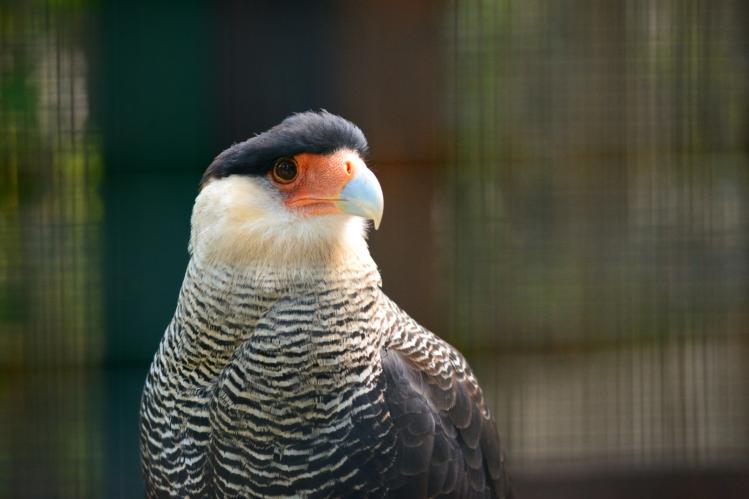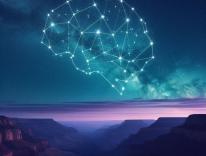
Imagine yourself as a star-nosed mole. You are about the size of a hamster, and you live most of your life underground in darkness. For this reason, you depend upon the eleven pairs of pink sensors that jut out from the front of your face. You depend upon them for everything: to sense the tunnels around you, the objects you encounter, the food before you. These sensations are nearly instantaneous, reaching the brain in about ten milliseconds. Imagine yourself rooting about in the dark, living by the pressure on the front of your face, forming a vision of the world entirely via touch.
We might be forgiven for assuming that other creatures perceive the world more or less as we do. But we would be mistaken. Our world is full of creatures with sensory organs so different from our own as to render their lives unimaginable to us. This is the premise of the philosopher Thomas Nagel’s groundbreaking essay “What Is It Like to Be a Bat?”: “In so far as I can imagine this (which is not very far), it tells me only what it would be like for me to behave as a bat behaves. But that is not the question. I want to know what it is like for a bat to be a bat.” If one’s perceptions constitute one’s sense of being in the world, then how could we possibly hope to imagine ourselves in the lives of those whose perceptions are nothing like our own?
In An Immense World, Ed Yong gives it a shot. Yong is a science writer at the Atlantic, where he has published some of the best reporting on the COVID-19 pandemic, but his background is in reporting about the nonhuman world. His first book, I Contain Multitudes, is on the subject of microbes, and he has published articles on endangered whales, malaria, mushroom parasites, and corals. In his new book, he takes on the vast subject of animal senses, attempting to synthesize hundreds of years of research into a tight 350 pages.
Yong is trying to tug readers beyond their own experience and intuitions into the deeply alien world of nonhuman lives. He begins his book with an account of the German zoologist Jakob von Uexküll’s concept of the Umwelt: environment, literally, but more “specifically the part of [an animal’s] surroundings that an animal can sense and experience—its perceptual world.” All animals perceive some things and do not perceive others. Consider the tick, which senses heat and skin odor but has no need to perceive color. Uexküll compared the Umwelt to a house whose many windows open onto a garden, and whose view of the garden depends on which windows open when, and onto what. “Each species is constrained in some ways,” Yong writes, “and liberated in others.”
As Yong shows, the animal kingdom is full of wildly diverse kinds of perception. Deep sea creatures evolved in a zone without sunlight and proceed largely according to the signals they gather from the movement of the water around them. Tiny insects hunt and communicate using vibrations on the surface of a leaf. Many animals see deep into the ultraviolet end of the color spectrum, perceiving patterns and colors invisible to the human eye. Cock-eyed squid have evolved two different kinds of eye, one to look upward for prey in downwelling sunlight, the other to search for bioluminescence below. Pit vipers have developed immensely sensitive nerve endings that can perceive changes in temperature of as little as .001°C, which enables them to hunt in the dark. The whiskers of harbor seals track fish by detecting invisible water trails.
As the previous paragraph suggests, the collection of facts in An Immense World can overwhelm the reader; the book has so much information to convey that it rarely devotes more than a few pages to any particular example. This has real implications for the ideas Yong is trying to get across. In his final chapter, he draws the reader’s attention to the many ways in which human beings are polluting the sensory landscapes of the world’s creatures, distracting their specially honed sensors with new sounds, colors, smells, and physical sensations. Migrating birds are distracted by beaming lights; giant whales find their hearing diminished by container ship traffic; bats crash into the windows that don’t return their sonar pings. And this is to say nothing of all the species made extinct by humans. “With every creature that vanishes,” Yong writes, “we lose a way of making sense of the world.” But perhaps because of the size of his topic, those ways of making sense only rarely come into focus. The scientific methods of establishing how we know what we know about the way other animals perceive the world can sometimes take precedence over the perceptions themselves. While Umwelt can be translated to mean “environment,” the original German is much broader—from welt, meaning “world,” and um, meaning “around,” “surrounding,” “total.” Umwelt suggests the full world that comes into view when several senses combine in the mind of an animal. We can observe how an animal responds to discrete stimuli, but not how those sensations are experienced, together with others. Yong tells us that songbirds have begun to alter their calls to combat urban noise, but we as readers have no idea what it is for one bird to sing to another bird, and for that other bird to hear it. Whatever the song means to them is not what it means to us, however sophisticated our instruments for recording it. That humbling gap is sometimes obscured by all the scientific research Yong has gathered in this timely book. What is it like to be a bird? We still don’t know.
It’s that same question that the musician, naturalist, and now author Jonathan Meiburg explores in A Most Remarkable Creature, now out in paperback. But first he must establish what, exactly, a bird even is. His subject is the caracara, a subfamily of five falcon species native to Central and South America. The first birds were feathered dinosaurs and emerged in the aftermath of the Cretaceous extinction, repopulating the earth over the next ten million years. As Meiburg notes, it took another forty million years for a recognizable ancestor of human beings to emerge—about ten million years ago. In short, birds have been around much longer than we have.
The landmass that then comprised what are now Australia, Antarctica, and South America proved especially hospitable: at least twelve different lineages of feathered dinosaurs survived in the southern hemisphere, and their descendants continue to thrive. It’s a lot, but Meiburg’s fluid storytelling is necessary for establishing how caracaras came to be, which allows him to explore what they now are. Caracaras are immensely clever, communicative, and social. In an experiment, one group of Argentinian chimango caracaras were shown how to open a closed plexiglass box with a piece of food. A second group was shown the food in the box, but not how to open it, yet learned the technique simply by watching the first group doing it successfully. “The observer chimangos had learned,” Meiburg writes, “from a single observation, that an object they’d never seen before contained food, and their peers’ actions had taught them how to get at it.”
This remarkable intelligence is reflected in the caracaras’ remarkable adaptability. Caracaras evolved in South America, isolated from human contact until fourteen thousand years ago, at the earliest. Yet they have very quickly adapted to the human presence, hanging around dumps and garbage tips, waiting outside back doors, and visiting generous windowsills even in major cities like La Paz. In the Falklands, an isolated group of islands three hundred miles east of mainland Argentina, striated caracaras—also known as Johnny Rooks—flit between their rocky roosts and the islands’ isolated residences, feasting on both penguin chicks and kitchen scraps.
Their willingness to approach and interact with humans and human things has long made the birds an object of fascination. Meiburg first encountered the Johnny Rook on the Falklands when he was a younger man, just out of college and exploring remote settlements around the world. He found himself disarmed by caracaras’ curiosity and even their impishness, their willingness to tag along beside an unknown person, pluck hats from heads, tug at backpack zippers, and stare a person right in the face. “The first ones I saw,” he writes, “stared back at me so intensely that I felt slightly abashed, as if I owed them an explanation.”
The birds left a similar, if less fond, impression on Darwin when the Beagle called in at the Falklands; they even stole his hat. Meiburg devotes substantial space to the naturalist and writer William Henry Hudson, who grew up on the Argentinean pampas and died in England, longing for the flora and fauna of his youth. The caracaras left a particular impression upon his memories. He described them as “a species so cosmopolitan in its tastes,” and in their social intelligence he recognized a certain resemblance to human beings. They helped spur the passionate argument he often made in print about the rich interior worlds of animals. Meiburg quotes him as writing: “All that is in our minds is also in theirs.”
Yong would object to this as untutored anthropomorphism—a failure to acknowledge that other species perceive the world very differently from the way we do. But perhaps Hudson only meant that the minds of other animals capture as much of the world as ours do. In focusing on this single subfamily of birds, Meiburg’s wonderful book prods at our preconceptions about what counts as intelligence, and suggests that certain qualities we associate uniquely with human beings are to be found in other creatures. “If the ability to train your own intuition, rather than waiting on natural selection to do it for you, leads to the process that we might call consciousness,” he writes of the chimangos, “then another name for ‘socially transmitted adaptive behavior patterns’—compounding the insights of individual consciousness—is culture.”
An Immense World
Ed Yong
Random House
$30 | 464 pp.
A Most Remarkable Creature
Jonathan Meiburg
Vintage
$20 | 400 pp.
Please email comments to [email protected] and join the conversation on our Facebook page.
Previous Story
Asphalt Wasteland
Next Story
Too Late for Grace?


